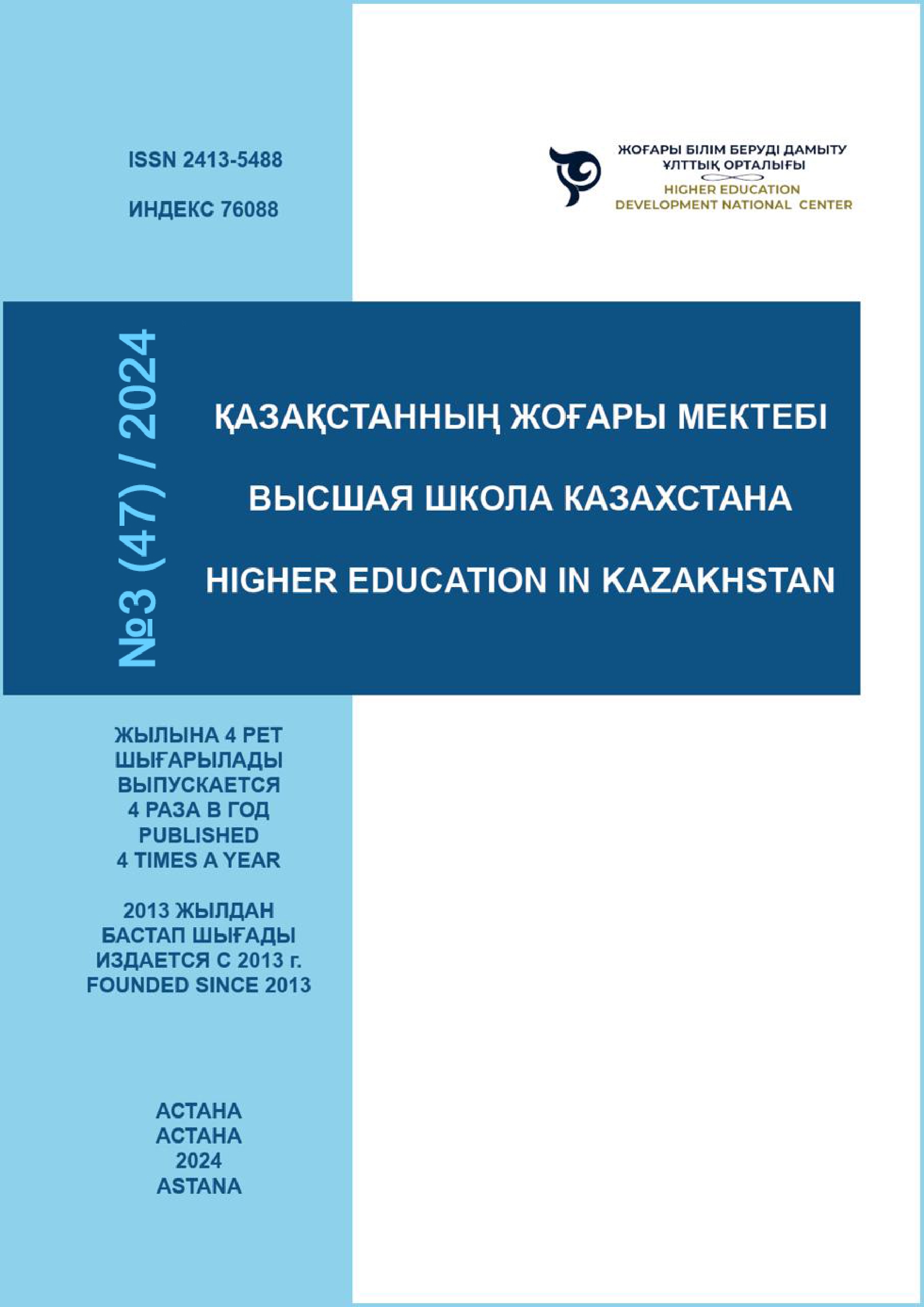THE ROLE OF TEACHER TRAINING IN FACILITATING THE ADOPTION OF DIGITAL TECHNOLOGIES IN ART EDUCATION
DOI:
https://doi.org/10.59787/2413-5488-2024-47-3-38-50Abstract
As technology plays an increasingly prominent role in education, the undeniable need for training programs aimed at equipping teachers with digital technology skills in art education becomes evident. This case study, conducted within the Abai Kazakh National Pedagogical University framework, examines teacher training programs, the challenges teachers face in integrating technology, and art faculty members' learning motivations and preferences. The research employs a descriptive survey, utilizing a questionnaire to collect data. Participants included 25 art professors from the Art Education, Graphic Design, and Visual Arts departments, who responded to questions about teaching methods across three areas: experiential learning, self-directed learning, and institutional learning. The results indicate that the teachers' level of self-directed learning, with an average of 3.7, was higher than experiential and institutional learning. This suggests that teachers are making considerable personal efforts to improve their skills. Additionally, they rated the necessity of institutional training programs as 4.0 (very high), though the challenges they face when using technology were rated at 2.9. The findings reveal that teachers' academic rank influences their perspectives on digital technologies. These insights can help pave the way for educational institutions in Kazakhstan to develop more technology-driven curricula in the future.
References
Lawrence, J. E. (2013). A Practical Guide for Developing Research Proposal in IS: A Guide for Developing Research Proposal in Information Systems. LAP Lambert Academic Publishing.
Lawrence, J. E., & Tar, U. A. (2018). Factors influencing teachers’ adoption and integration of ICT in the teaching/learning process. Educational Media International, 55(1), 79–105. https://doi.org/10.1080/09523987.2018.1439712
Balanskat, A., Blamire, R., & Kafal, S. (2007). A review of studies of ICT impact on schools in Europe. Europeanschoolnet. http://unpan1.un.org/intradoc/groups/public/documents/unpan/unpan037334.pdf
Lim, C. P., & Chai, C. S. (2008). Teachers’ pedagogical beliefs and their planning and conduct of computer‐mediated classroom lessons. British Journal of Educational Technology, 39(5), 807–828. https://doi.org/10.1111/j.1467-8535.2007.00774.x
Sherry, L., & Gibson, D. (2002). The path to teacher leadership in educational technology. Contemporary Issues in Technology and Teacher Education, 2(2), 178–203. https://www.learntechlib.org/p/10751/article_10751.pdf
Rowe, Ken, "The Importance of Teacher Quality As A Key Determinant of Students’ Experiences and Outcomes of Schooling" (2003). https://research.acer.edu.au/research_conference_2003/3
Zhu, C., & Urhahne, D. (2018). Using learner response systems in the classroom enhances teachers’ judgment accuracy. Learning and Instruction, 58, 255–262. https://doi.org/10.1016/j.learninstruc.2018.07.011
Paetsch, J., Franz, S., & Wolter, I. (2023). Changes in early career teachers’ technology use for teaching: The roles of teacher self-efficacy, ICT literacy, and experience during COVID-19 school closure. Teaching and Teacher Education, 135, 104318. https://doi.org/10.1016/j.tate.2023.104318
Martin, B. (2015). Successful implementation of TPACK in teacher preparation programs. International Journal of Integrating Technology in Education, 4(1), 17–26. https://doi.org/10.5121/ijite.2015.4102
Tondeur, J., Van Braak, J., Sang, G., Voogt, J., Fisser, P., & Ottenbreit-Leftwich, A. (2012). Preparing pre-service teachers to integrate technology in education: A synthesis of qualitative evidence. Computers & Education, 59(1), 134–144. https://doi.org/10.1016/j.compedu.2011.10.009
Valtonen, T., Pöntinen, S., Kukkonen, J., Dillon, P., Väisänen, P., & Hacklin, S. (2011). Confronting the technological pedagogical knowledge of Finnish Net Generation student teachers. Technology, Pedagogy and Education, 20(1), 3–18. https://doi.org/10.1080/1475939x.2010.534867
COL (2020). Guidelines on Distance Education during COVID-19. Burnaby: COL. Retrieved from http://hdl.handle.net/11599/3576
Voogt, J., Erstad, O., Dede, C., & Mishra, P. (2013). Challenges to learning and schooling in the digital networked world of the 21st century. Journal of Computer Assisted Learning, 29(5), 403–413. https://doi.org/10.1111/jcal.12029
Moreira, M. Á., Hernández-Rivero, V., & Alonso, J. J. S. (2016). Models of educational integration of ICTs in the classroom. Comunicar, 24(47), 79–87. https://doi.org/10.3916/c47-2016-08
Goeman, K., Elen, J., Pynoo, B., & Van Braak, J. (2015). Time for action! ICT Integration in Formal Education: Key Findings from a Region-wide Follow-up Monitor. TechTrends, 59(5), 40–50. https://doi.org/10.1007/s11528-015-0890-6
Pachler, N., Preston, C., Cuthell, J., Allen, A., & Pinheiro-Torres, C. (2010). ICT CPD Landscape: Final report. Becta. https://dera.ioe.ac.uk/1769/
Backfisch, I., Lachner, A., Stürmer, K., & Scheiter, K. (2021). Variability of teachers’ technology integration in the classroom: A matter of utility! Computers & Education, 166, 104159. https://doi.org/10.1016/j.compedu.2021.104159
Scherer, R., Siddiq, F., & Tondeur, J. (2019). The technology acceptance model (TAM): A meta-analytic structural equation modeling approach to explaining teachers’ adoption of digital technology in education. Computers & Education, 128, 13–35. https://doi.org/10.1016/j.compedu.2018.09.009
Teo, T. (2011). Factors influencing teachers’ intention to use technology: Model development and test. Computers & Education, 57(4), 2432–2440. https://doi.org/10.1016/j.compedu.2011.06.008
Vongkulluksn, V. W., Matewos, A. M., Sinatra, G. M., & Marsh, J. A. (2018). Motivational factors in maker spaces: a mixed methods study of elementary school students’ situational interest, self-efficacy, and achievement emotions. International Journal of STEM Education, 5(1). https://doi.org/10.1186/s40594-018-0129-0
Joo, Y. J., Park, S., & Lim, E. (2018). Factors influencing preservice teachers’ intention to use technology: TPACK, teacher self-efficacy, and technology acceptance model. Educational Technology & Society, 21(3), 48–59. https://203.255.161.86/handle/2015.oak/245215
Siddiq, F., Hatlevik, O. E., Olsen, R. V., Throndsen, I., & Scherer, R. (2016). Taking a future perspective by learning from the past – A systematic review of assessment instruments that aim to measure primary and secondary school students’ ICT literacy. Educational Research Review, 19, 58–84. https://doi.org/10.1016/j.edurev.2016.05.002
Νικολοπούλου, Κ., & Gialamas, V. (2015). Barriers to ICT use in high schools: Greek teachers’ perceptions. Journal of Computers in Education, 3(1), 59–75. https://doi.org/10.1007/s40692-015-0052-z
Simpson, J. C. (2023). ISTE Research Study: Transforming Teacher Education. International Society for Technology in Education.
Santos, D. a. D. N. D., Schlünzen, E. T. M., & Schlünzen, K. (2016). Teachers are training for the use of digital technologies. Universal Journal of Educational Research, 4(6), 1288–1297. https://doi.org/10.13189/ujer.2016.040606
Buabeng-Andoh, C. (2012). Factors influencing teachers’ adoption and integration of information and communication technology into teaching: A review of the literature. International Journal of Education and Development Using Information and Communication Technology, 8(1), 136–155. http://files.eric.ed.gov/fulltext/EJ1084227.pdf
Vannatta, R., & Fordham, N. (2004). Teacher dispositions as predictors of classroom technology use. Journal of Research on Technology in Education, 36(3), 253–271. https://doi.org/10.1080/15391523.2004.10782415














